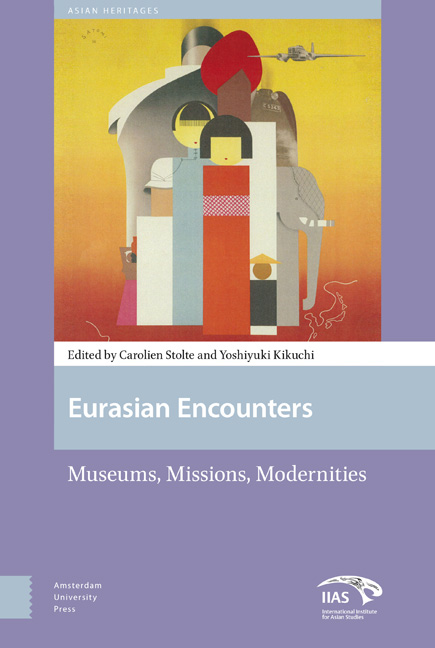Book contents
- Frontmatter
- Contents
- 1 Eurasian Encounters: Cross-border Intellectual and Cultural Exchange, 1900-1950
- Part I Artistic Spaces
- 2 The Museum at Aundh: Reflecting on Citizenship and the Art Museum in the Colony
- 3 Exhibiting the Nation: Cultural Flows, Transnational Exchanges, and the Development of Museums in Japan and China, 1900-1950
- 4 Parallel Tracks: Pan Yuliang and Amrita Sher-Gil in Paris
- 5 Bauhaus and Tea Ceremony: A Study of Mutual Impact in Design Education between Germany and Japan in the Interwar Period
- Part II Missions and Education
- 6 Schooling a Missionary in Early Twentieth-Century Eastern India
- 7 The Catholic Church in China in the First Half of the Twentieth Century: The Establishment of Zhendan University and Furen University
- Part III Shared Trajectories, New Subjectivities
- 8 Indigenizing Cosmopolitanism: Shifting Metropolitan Subjectivities in Twentieth-century Colombo
- 9 Fighting for the Soviet Empire: War Propaganda Production and Localized Discourses on Soviet Patriotism in Uzbekistan during the Second World War
- 10 Shared Origins, Shared Outcomes?: Transcultural Trajectories of Germany and Japan during the Asia-Pacific War
- Index
5 - Bauhaus and Tea Ceremony: A Study of Mutual Impact in Design Education between Germany and Japan in the Interwar Period
Published online by Cambridge University Press: 12 December 2020
- Frontmatter
- Contents
- 1 Eurasian Encounters: Cross-border Intellectual and Cultural Exchange, 1900-1950
- Part I Artistic Spaces
- 2 The Museum at Aundh: Reflecting on Citizenship and the Art Museum in the Colony
- 3 Exhibiting the Nation: Cultural Flows, Transnational Exchanges, and the Development of Museums in Japan and China, 1900-1950
- 4 Parallel Tracks: Pan Yuliang and Amrita Sher-Gil in Paris
- 5 Bauhaus and Tea Ceremony: A Study of Mutual Impact in Design Education between Germany and Japan in the Interwar Period
- Part II Missions and Education
- 6 Schooling a Missionary in Early Twentieth-Century Eastern India
- 7 The Catholic Church in China in the First Half of the Twentieth Century: The Establishment of Zhendan University and Furen University
- Part III Shared Trajectories, New Subjectivities
- 8 Indigenizing Cosmopolitanism: Shifting Metropolitan Subjectivities in Twentieth-century Colombo
- 9 Fighting for the Soviet Empire: War Propaganda Production and Localized Discourses on Soviet Patriotism in Uzbekistan during the Second World War
- 10 Shared Origins, Shared Outcomes?: Transcultural Trajectories of Germany and Japan during the Asia-Pacific War
- Index
Summary
Abstract
The impact of the Bauhaus teaching methods, particularly Johannes Itten's (1888-1867) Preparatory Course, reached far beyond Germany. Conversely, Japanese sensibility permeated the Bauhaus throughout its history until its closure in 1933, springing from the japonisme of individual professors, and most notably from Itten's interest in Japanese and Chinese art and philosophy. Contemporary Yamawaki Michiko described the Japanese atmosphere in the Bauhaus in her book The Bauhaus and the Tea Ceremony. The energetic activity of expatriate Japanese artists in Berlin and other central European cities has otherwise received relatively little attention. However, these Japanese artists provided the channel for promoting the Bauhaus in Japan, and it did not take long for several schools, including Jiyū Gakuen and the New Bauhaus, founded in 1932 in Tokyo, to adopt Bauhaus methodology. This chapter analyses the mutual impact in design education between Germany and Japan in order to shed new light on this tightly knit network of associations connecting Japan and Europe in the interwar period.
Introduction
The impact of the Bauhaus teaching methods, particularly Johannes Itten’s (1888-1967) Preparatory Course, has been lasting and extensive. In the 1920s and 1930s, Germany had one of the leading progressive art scenes in the world. Avant-garde groups and galleries, as well as the Bauhaus and other similar art schools, such as the Itten-Schule and Reimann-Schule, appealed to large numbers of international students, including Japanese, and created a transnational network around them.
Prolific thinker and architect Bruno Taut (1880-1938) commenced his lecture Fundamentals of Japanese Architecture, presented in Japan in 1936, with the statement that ‘the exotic no longer exists in Europe for Japan, or in Japan for Europe’. In other words, in the period between the two world wars, Japan had already lost its exotic charm and Japanese culture had become relatively common as a subject of interest. Japanese artists took an active part in artistic dialogue internationally, and intelligentsias all over the world contemplated Japanese aesthetics and philosophical ideas. This chapter will analyse the mutual impact of design education between Germany and Japan in order to shed new light on this tightly knit network of associations connecting Japan and Europe in the interwar period.
The foundation of the contemporary avant-garde in Central Europe was a combination of diverse sources such as the English Arts and Crafts movement and japonisme.
- Type
- Chapter
- Information
- Eurasian EncountersMuseums, Missions, Modernities, pp. 103 - 120Publisher: Amsterdam University PressPrint publication year: 2017



